[Editor’s Note: Mad Scientist Laboratory is pleased to present the following post by returning guest blogger Mr. Frank Prautzsch, addressing the Black Swans and Pink Flamingos associated with our last terrestrial frontier — the Arctic. Mr. Prautzsch has previously posted on how the future of vaccines is in nano-biology and convergence with the immune system of the body.]
By now, all Mad Scientists and understudies of history are familiar with the conditions for the unknown, unknowns (i.e., Black Swans) and the known, knowns (i.e., Pink Flamingos). Perhaps no place has a greater collection of these attributes than the Arctic. The Arctic Region remains arguably our last international frontier. Over the last 20 years, climate change, unexplored energy reserves, short transpolar navigation, eco-tourism, and commerce (with and without indigenous populations) are taking center stage among stakeholders. This focused international interest in the Arctic has pronounced security implications.
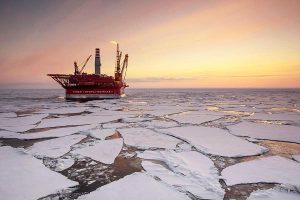
To start our Arctic flamingo category, potential energy reserves take center stage. The US Geological Survey estimates that the Arctic holds 18-23% of the untapped oil reserves remaining on the planet. Alaska and West Siberia are estimated to hold 30% of the world’s remaining gas reserves. Russia has attained strategic deals with Exxon Mobil, Eni, and Statoil for securing up to $500B in investment over the next 30 years. Shell paid $2.1B for 275 blocks of off-shore drilling plots northwest of Alaska, but has encountered difficulties in the harsh climate. The United States and Norway are building stronger partnerships on Arctic drilling.[1]
Perhaps the largest flamingo, and also the leader of the flock (or flamboyance), is the Russian military. Most of the Arctic Ocean littoral states are modernizing their military forces in the Arctic. With countries rebuilding their Arctic military capabilities, in concert with vague territorial zones, rich natural resource options, and no real enforcement of maritime law, some concern should be paid to any Russian attempt to have prime sectors of the Arctic become a “new Crimea”. This is a particularly acute topic should Russia model its behaviors after China and the lack of a concerted international community response to China’s sovereignty claims in the South China Sea.
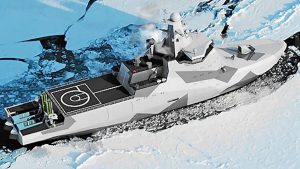
In August of 2007, two Russian mini-subs planted a Russian flag on a titanium mast 14,000 feet below the North Pole. This was tied to their interpretation of the 1982 UN Convention on the Law of the Sea allowing nations to claim sub terrain beyond 200 nautical miles if they prove that such a location is part of their continental shelf.
In the summer of 2014, “Putin broke away from talking about the Ukraine, and indicated that Russia’s future really didn’t lie to its west, but instead in the north. ‘Our interests are concentrated in the Arctic…. And of course, we should pay more attention to issues of development of the Arctic and the strengthening of our position [there].’”[2]
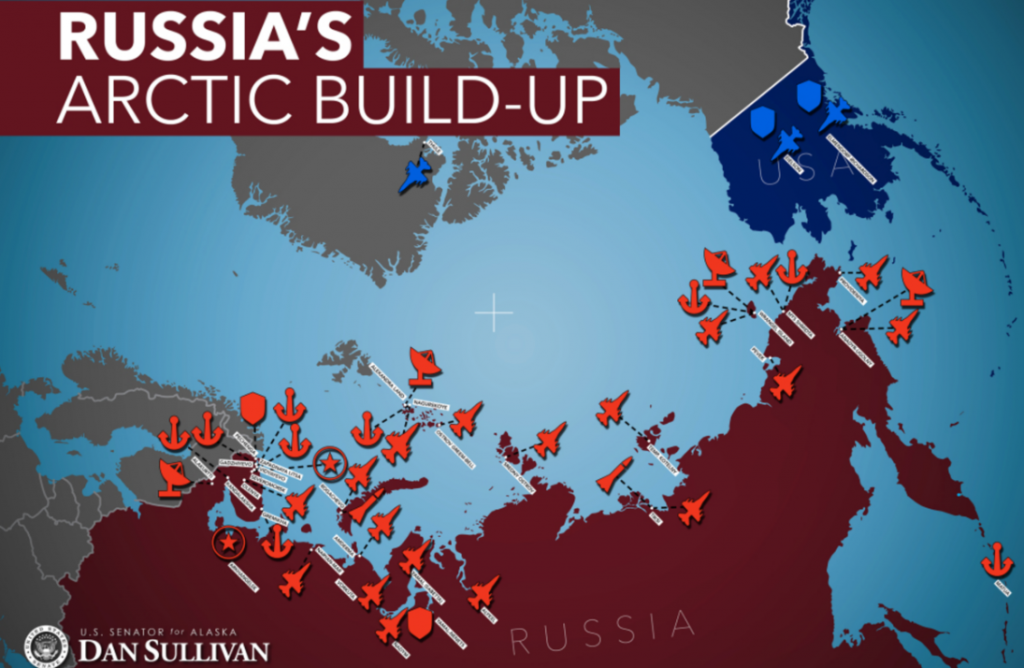
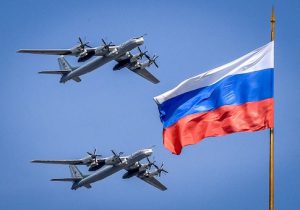
For the past 4 years, Norway, Finland, and Sweden joined much of the international community to overtly criticize Russian representatives and share their disappointment over Russian violation of international and maritime law by invading Crimea and the Ukraine. Finland and Sweden are exploring NATO membership. The volume of Russian TU-97 Bear C4ISR over flights of Finland’s and Sweden’s waters has gone up exponentially. The bombers are flying C4ISR missions but could easily be armed to follow through with their primary mission.[3]

The day after sanctions were placed on Russia for the invasion of Crimea and their activities in the Ukraine, President Putin moved an expeditionary naval fleet into the Arctic. The ships were dispatched to deliver personnel, equipment, and supplies to the New Siberian Islands where a permanent base was constructed. Central to this operation are revitalized military bases at Kotelny and Wrangel Islands, which were abandoned in 1993. Kotelny now has an airbase and is permanent home of the 99th Arctic Tactical Group. Another new air base was commissioned at Cape Schmidt. Additionally, an expanded airstrip at Novaya Zemlya can now accommodate fighters supporting the Northern Fleet. These moves have prompted serious criticism from Canada.

In addition to Kotelny, the Russian Northern Fleet has expanded operations from the Russian town of Alakurtti, Murmansk, which is 50km from the Finnish border. Large portions of the rest of the Northern Fleet are now there with a full complement of 39 ships and 45 submarines. Alakurtti is the new garrison for the Russian Arctic Command with 6000 + Arctic-trained ground troops. Russia maintains a fleet for 54 icebreakers and 78 icebreaker-hulled oil/gas supertankers, while the US maintains one heavy breaker and has hopes of acquiring three more. Russia feels that they have to move to the Arctic Ocean to secure their energy future, and to protect the economic interests of their country. The Russians intend to “homestead”, realizing that global energy supplies will again favor their geographical posture someday.[4] From this strategic position, they maintain multiple black swan options, for which the West will have little to challenge.

Reinforcing these energy efforts in the Arctic, Russia deployed its first floating nuclear power plant in April 2018. Moving slowly from St. Petersburg, its final destination is Pevek on the Arctic coast, where it will replace a land-based nuclear power source.[5] This position is 86km from Alaska and the installation uses similar reactor technology to that of Russian icebreaker ships.[6] The primary concern of the international community is the potential for a nuclear accident, but this new power plant could serve a broader Russian purpose in sequestering and dominating the Arctic and its resources.
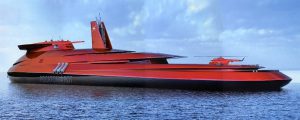
One of the baby black swans in the Arctic is our unknown ability to generate a clear national will and investment for heavy icebreakers. The US Coast Guard seeks to build three heavy and three medium icebreakers of US lineage. The entire world (including Russia) seeks the help of Finland in icebreaker building and development. With a lack of port construction facilities and a Request for Proposal for three heavy icebreakers from untested US designs, this cygnet will fight for survival against cost, schedule, performance, and risk. While it all looks good on paper, the operational risks to Arctic operations between now and 2025 are pronounced. At the end of the day, the US should consider modular multi-role heavy icebreaker oil/gas tanker hulls that could be tailored to support multiple US missions and interests, including ship escort duty, refueling, C4ISR, vertical lift support, contingency maneuver asset delivery, oil recovery, medical, SAR, and scientific missions…not just icebreaking.
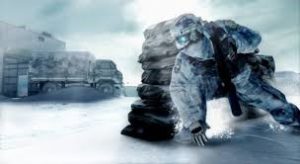
Another indigo black swan is the US Army’s and its Sister Services’ cold weather climate equipment and training. We must improve our survival techniques, mobility and transport, and combat capabilities in cold weather. In a recent Arctic exercise, the US Marine Corps borrowed arctic tentage and soldier wearables from Sweden and Norway. US Arctic tentage has not changed since the mid 1950s. A recent Request for Information introduces the USMC to its first change in cold weather hats and gloves in decades. It is also important to understand the lack of available C4ISR, the performance of commercial off the shelf C4ISR systems subjected to heating and condensation cycles, and the effects of cyber on C4ISR and transportation. Failure in any of these mission areas will render a highly capable force almost useless.

Finally, the most enormous black swan on the planet resides in the Arctic tied to climate change. The introduction of pronounced Arctic sheet ice melting over the past eight summers has opened up the potential for at least seasonal trans-polar shipping and also selected air routes. While we are in love with pretty pictures of polar bears on ice floes and satellite imagery of an ever-shrinking mass, the true story is 3D. We soon will not have Arctic ice of any accumulated age. This is due to warm subsurface ocean thermoclines and high densities of chlorophyll not before seen. Certain NOAA models predict “Ice Free” Arctic Summers by 2047. The impact on climate, fish/wildlife, weather severity, sea levels, and of course human beings is far from being understood. The ice shelves of Greenland are losing one cubic mile of fresh water per week. This is the equivalent of all of the drinking water consumed by Los Angeles in a year.
So, what do we know going into the unknown? (National Geographic, April 2017)
1. The earth’s temperature goes up and down, but it’s gone up 1.69 deg. F consistently since the end of WWII.
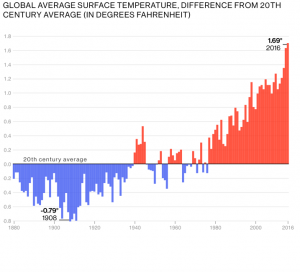
2. CO2 warms the planet and we have increased the amount of CO2 by almost half since 1960.
3. 97% of scientists and 98% of authors fault humans for global warming.
4. Arctic sea ice is shrinking and glaciers are receding worldwide.
5. The number of climate-related disasters has tripled since 1980.
6. Retreat and extinction of various plants and animals is starting to occur.
7. Albeit noble, the switch to renewable energy does not offset the world appetite for energy.
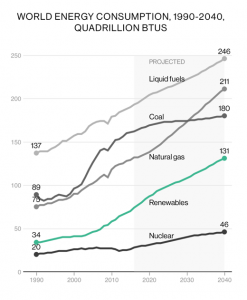
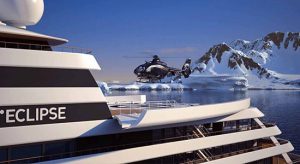
While the green-think world worries, commerce is casting an eye on how the Northwest Passage can cut shipping distances between Asia and Europe by up to 3500-4500 miles. A French cruise line is preparing for trans-polar cruises during optimal weather and navigation times. Russia will seek transit and escort fees over its sovereign territories. Reykjavik, Iceland is labeled as the Singapore of 2050. The truth is we will all have to challenge the unknowns of this great swan over time, and we are ill prepared for this confrontation. While Russia looks like a flamingo, its Arctic behaviors can be totally swan-like. If we are looking into the future, we must fear our drift towards fair-weather Clausewitzian warfare while the rest of the planet sees otherwise. Enjoy the birds!
In his current role as President of Velocity Technology Partners LLC, Mr. Frank Prautzsch (LTC, Ret. Signal Corps) is recognized as a technology and business leader supporting the government and is known for exposing or crafting innovative technology solutions for the DoD, SOF, DHS and Intelligence community. He also provides consult to the MEDSTAR Institute for Innovation. His focus is upon innovation and not invention. Mr. Prautzsch holds a Bachelor of Science in Engineering from the United States Military Academy at West Point, is a distinguished graduate of the Marine Corps Signal Advanced Course, Army Airborne School, Ranger School, and Command and General Staff College. He also holds a Master of Science Degree from Naval Postgraduate School in Monterey, California with a degree in Systems Technology (C3) and Space.
______________________________________________________
[1] CNN Money, July 19, 2012, http://money.cnn.com/2012/07/17/news/economy/Arctic-oil/index.htm
[2] The Washington Post, Aug 29, 2014, http://www.washingtonpost.com/blogs/worldviews/wp/2014/08/29/putin-thinks-of-the-past-when-talking-ukraine-but-the-arctic-is-where-he-sees-russias-future/
[3] Minutes of Arctic Circle Conference, Reykjavik Iceland, Oct 2014.
[4] The Guardian, 21 October 2014, http://theguardian.com/world/2014/oct/21/russia-arctic-military-oil-gas-putin
[5] NPR, April 30, 2018, https://www.npr.org/sections/thetwo-way/2018/04/30/607088530/russia-launches-floating-nuclear-power-plant-its-headed-to-the-arctic
[6] Live Science, May 21, 2018, https://www.livescience.com/62625-russia-floating-nuclear-power-arctic-alaska.html

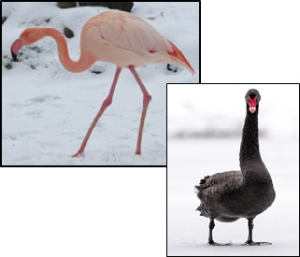

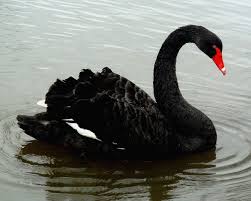 Black Swans: In Nassim Nicholas Taleb’s original context, a black swan (unknown, unknowns) is an event or situation which is unpredictable, but has a major effect. For this conference, we used a looser definition, identifying possibilities that are not likely, but might have significant impacts on how we think about warfighting and security.
Black Swans: In Nassim Nicholas Taleb’s original context, a black swan (unknown, unknowns) is an event or situation which is unpredictable, but has a major effect. For this conference, we used a looser definition, identifying possibilities that are not likely, but might have significant impacts on how we think about warfighting and security. Pink Flamingos: Defined by
Pink Flamingos: Defined by 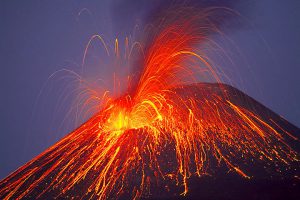 • Naturally Occurring Disaster: These events (i.e., Carrington Event — solar flare frying solid state electronics, super volcano eruptions, earthquake swarms, etc.) would have an enormous impact on the Army and its ability to continue to operate and defend the nation and support national recovery operations. While warning times have increased for many of these events, there are limited measures that can be implemented to mitigate the devastating effects of these events.
• Naturally Occurring Disaster: These events (i.e., Carrington Event — solar flare frying solid state electronics, super volcano eruptions, earthquake swarms, etc.) would have an enormous impact on the Army and its ability to continue to operate and defend the nation and support national recovery operations. While warning times have increased for many of these events, there are limited measures that can be implemented to mitigate the devastating effects of these events. • Virtual Nations: While the primacy of Westphalian borders has been challenged and the power of traditional nation-states has been waning over the last decade, some political scientists have assumed that supranational organizations and non-state actors would take their place. One potential black swan is the emergence of virtual nations due to the convergence of blockchain technologies, crypto-currency, and the ability to project power and legitimacy through the virtual world. Virtual nations could be organized based on ideologies, business models, or single interests. Virtual nations could supersede, supplement, or compete with traditional, physical nations. The Army of the future may not be prepared to interact and compete with virtual nations.
• Virtual Nations: While the primacy of Westphalian borders has been challenged and the power of traditional nation-states has been waning over the last decade, some political scientists have assumed that supranational organizations and non-state actors would take their place. One potential black swan is the emergence of virtual nations due to the convergence of blockchain technologies, crypto-currency, and the ability to project power and legitimacy through the virtual world. Virtual nations could be organized based on ideologies, business models, or single interests. Virtual nations could supersede, supplement, or compete with traditional, physical nations. The Army of the future may not be prepared to interact and compete with virtual nations. • Competition in Venues Other than Warfare (Economic, Technological, Demographic, etc.) Achieving Primacy: In the near future, war in the traditional sense may be less prevalent, while competitions in other areas may be the driving forces behind national oppositions. How does the Army need to prepare for an eventuality where armed conflict is not as important as it once was?
• Competition in Venues Other than Warfare (Economic, Technological, Demographic, etc.) Achieving Primacy: In the near future, war in the traditional sense may be less prevalent, while competitions in other areas may be the driving forces behind national oppositions. How does the Army need to prepare for an eventuality where armed conflict is not as important as it once was? • Alternate Internet — “Alternet”: A distinct entity, separate from the general commercial internet, only accessible with specific corresponding hardware. This technology would allow for unregulated and unmonitored communication and commerce, potentially granting safe haven to criminal and terrorist activities.
• Alternate Internet — “Alternet”: A distinct entity, separate from the general commercial internet, only accessible with specific corresponding hardware. This technology would allow for unregulated and unmonitored communication and commerce, potentially granting safe haven to criminal and terrorist activities. • Safe at Home: Army installations are no longer the sanctuaries they once were, as adversaries will be able to attack Soldiers and families through social media and other cyberspace means. Additionally, installations no longer merely house, train, and deploy Soldiers — unmanned combat systems are controlled from home installations -— a trend in virtual power that will increase in the future. The Army needs a plan to harden our installations and train Soldiers and families to be resilient for this eventuality.
• Safe at Home: Army installations are no longer the sanctuaries they once were, as adversaries will be able to attack Soldiers and families through social media and other cyberspace means. Additionally, installations no longer merely house, train, and deploy Soldiers — unmanned combat systems are controlled from home installations -— a trend in virtual power that will increase in the future. The Army needs a plan to harden our installations and train Soldiers and families to be resilient for this eventuality.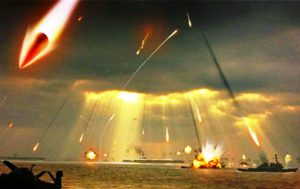 • Hypersonics: High speed (Mach 5 or higher) and highly maneuverable missiles or glide vehicles that can defeat our air defense systems. The speed of these weapons is unmatched and their maneuverability allows them to keep their targets unknown until only seconds before impact, negating current countermeasures.
• Hypersonics: High speed (Mach 5 or higher) and highly maneuverable missiles or glide vehicles that can defeat our air defense systems. The speed of these weapons is unmatched and their maneuverability allows them to keep their targets unknown until only seconds before impact, negating current countermeasures.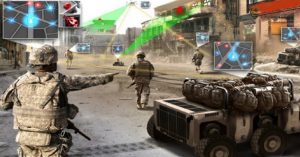 • Generalized, Operationalized Artificial Intelligence (AI):
• Generalized, Operationalized Artificial Intelligence (AI): 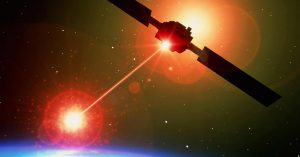 • Space/Counterspace: Space is becoming increasingly congested, commercialized, and democratized. Disruption, degradation, and denial in space threatens to cripple multi-domain warfare operations. States and non-state actors alike are exploring options to counter one another, compete, and potentially even fight in space.
• Space/Counterspace: Space is becoming increasingly congested, commercialized, and democratized. Disruption, degradation, and denial in space threatens to cripple multi-domain warfare operations. States and non-state actors alike are exploring options to counter one another, compete, and potentially even fight in space. • Quantum Sciences: Quantum science – communication, computing, and sensing – has the potential to solve some intractable but very specific problem sets. Quantum technology remains in its infancy. However, as the growth of qubits in quantum computing continues to expand, so does the potentiality of traditional encryption being utterly broken. Quantum sensing can allow for much more precise atomic clocks surpassing the precision timing of GPS, as well as quantum imaging that provides better results than classical imaging in a variety of wavelengths.
• Quantum Sciences: Quantum science – communication, computing, and sensing – has the potential to solve some intractable but very specific problem sets. Quantum technology remains in its infancy. However, as the growth of qubits in quantum computing continues to expand, so does the potentiality of traditional encryption being utterly broken. Quantum sensing can allow for much more precise atomic clocks surpassing the precision timing of GPS, as well as quantum imaging that provides better results than classical imaging in a variety of wavelengths. • Bioweapons/Biohacking: The democratization of
• Bioweapons/Biohacking: The democratization of  • Personalized Warfare: Warfare is now waged on a
• Personalized Warfare: Warfare is now waged on a 
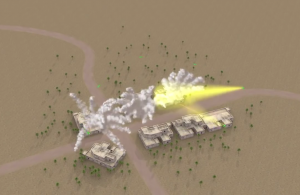 • Multi-Domain Swarming: Swarming is often thought about in terms of unmanned aerial systems (UAS), but one significant pink flamingo is swarming taking place across multiple domains with self-organizing, autonomous aerial, ground, maritime (sub and surface), and even subterranean unmanned systems. U.S. defense systems on a linear modernization and development model will not be capable of dealing with the saturation and complexity issues arising from these multi-domain swarms.
• Multi-Domain Swarming: Swarming is often thought about in terms of unmanned aerial systems (UAS), but one significant pink flamingo is swarming taking place across multiple domains with self-organizing, autonomous aerial, ground, maritime (sub and surface), and even subterranean unmanned systems. U.S. defense systems on a linear modernization and development model will not be capable of dealing with the saturation and complexity issues arising from these multi-domain swarms.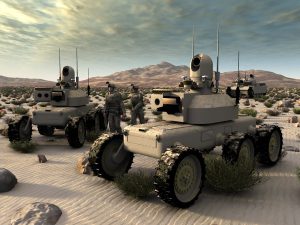 • Lethal Autonomy: An
• Lethal Autonomy: An 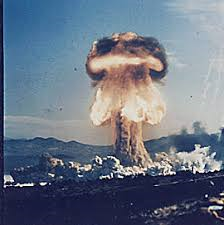 • Tactical Nuclear Exchange: While strategic nuclear war and mutually assured destruction have been discussed and addressed ad nauseam, not enough attention has been given to the potential of a tactical nuclear exchange between state actors. One tactical nuclear attack, while not guaranteeing a nuclear holocaust, would bring about a myriad of problems for U.S. forces worldwide (e.g., the potential for escalation, fallout, contamination of water and air, and disaster response). Additionally, a high altitude nuclear burst’s electromagnetic pulse has the potential to fry solid state electronics across a wide-area, with devastating results to the affected nation’s electrical grid, essential government services, and food distribution networks.
• Tactical Nuclear Exchange: While strategic nuclear war and mutually assured destruction have been discussed and addressed ad nauseam, not enough attention has been given to the potential of a tactical nuclear exchange between state actors. One tactical nuclear attack, while not guaranteeing a nuclear holocaust, would bring about a myriad of problems for U.S. forces worldwide (e.g., the potential for escalation, fallout, contamination of water and air, and disaster response). Additionally, a high altitude nuclear burst’s electromagnetic pulse has the potential to fry solid state electronics across a wide-area, with devastating results to the affected nation’s electrical grid, essential government services, and food distribution networks.